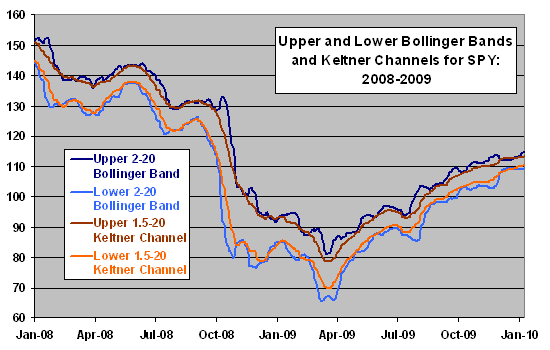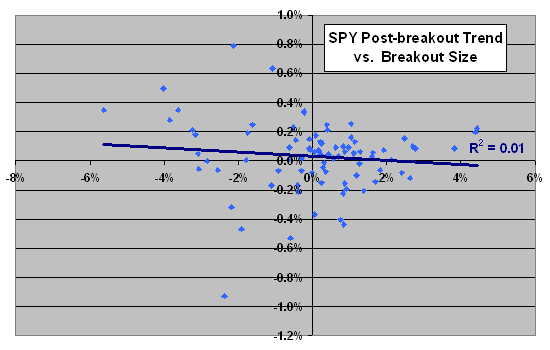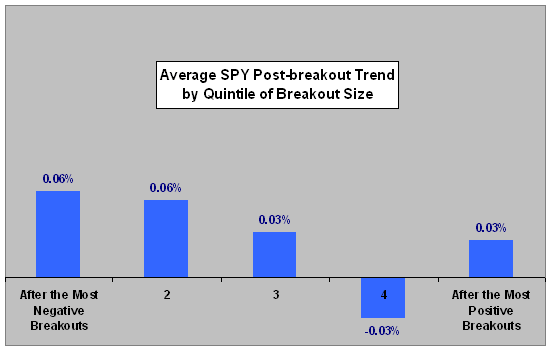A reader, citing a technical indicator recommended in Mastering the Trade by John Carter, inquired about the usefulness of watching for times when certain Bollinger Bands (upper and lower bounds two standard deviations from a 20-day simple moving average) converge within a certain Keltner Channel (upper and lower bounds 1.5 times the 20-day average range from a 20-day average typical price). Breakouts from this condition are supposedly reliable for both indexes and individual securities, meaning that price continues in same direction for a while without material reversal, because the condition represents true “consolidation.” There is no specification for trend duration after these “reliable” breakouts. Using daily high, low and unadjusted closing prices for S&P Depository Receipts (SPY) for band/channel calculations, and adjusted closing prices for return calculations, over the period 1/29/93 through 1/8/10 (nearly 17 years), we find that:
The following chart illustrates the Bollinger Band and Keltner Channel boundaries as specified during 2008-2009. Visual inspection shows that the former occasionally track inside the latter. However, visual inspection is not effective for measuring the reliability of subsequent breakouts over the entire sample period.

Calculations show that the Bollinger Band-within-Keltner Channel condition holds at the close for 818 out of 4250 trading days (19% of the time) over the entire sample period. These 818 days tend to cluster. We make the following assumptions to enable a systematic test of subsequent breakouts:
- The sum of daily close-to-close returns during the three trading days after Bollinger Band-within-Keltner Channel conditions end defines the direction and size of breakout. There are 126 such breakouts over the entire sample period. In other words, if the condition holds on Day 0 but not on Day 1, the return from the close on Day 0 to the close on Day 3 defines the breakout.
- The average daily close-to-close return during the 18 trading days after the breakout interval (for a total breakout-trend interval of 21 trading days or about a month) defines the direction and size of the post-breakout trend. The last breakout in the sample period is therefore too recent to use.
- Based on these definitions, breakouts that occur within a month (30 calendar days) of each other are not both exploitable. We therefore winnow the set of breakouts such that no two breakouts are within 30 calendar days of each other, leaving an exploitable sample of 86 breakouts (about one every 2.3 months on average).
Applying these assumptions, the following scatter plot relates the post-breakout trend for SPY to the associated SPY breakout over the entire sample period. The Pearson correlation for the two series is -0.11 and the R-squared statistic at 0.01, indicating that variation in breakouts explains just 1% of variation in subsequent trends. Any relationship is opposite the hypothesized belief.
For the unwinnowed sample of 125 breakouts, the Pearson correlation is -0.16.
In case the relationship is non-linear, we try a ranking.

The final chart summarizes the average SPY post-breakout trend by quintile of SPY breakouts over the entire sample period. Results across quintiles are not notably systematic. If anything, the post-breakout trend tends to be more positive after negative breakouts than after positive breakouts. Results do not support the hypothesized belief described above.
The quintile subsamples are small (just 17-18 observations each), so a few additional observations could alter results substantially.

In summary, evidence based on straightforward assumptions and tests does not support a belief that breakout indications after Bollinger Band-within-Keltner Channel conditions are reliable.
Modifying the test specifications and/or adding restrictions may produce different results, but would introduce data snooping bias.